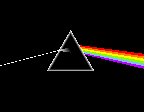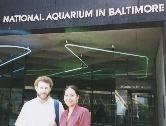Optics in the Fishtank

Optics in the Fishtank

Why is the sky blue? Why are sunsets red? How does light travel
through optical fibers? In order to answer these questions and
others through simple and interesting optics demonstrations, we
brought out our secret weapon: the fishtank.
Using a 10-gallon tank ($10) and an inexpensive laser pointer ($40) or a
He-Ne laser, a flashlight and a ruler, we can show many sophisticated effects
ranging from waveguiding to Rayleigh scattering. The OSA student
chapter at
Northwestern University has performed these interactive
demos at local high schools to encourage interest in modern optics.
The tank should contain a couple of inches of water (minus the fish).
By adding a few drops of milk to the water to enhance scattering,
the beam will be readily visible if the room lights are low.
If the laser source is polarized, try rotating it to maximize
the light (Rayleigh) scattered towards the sides. Best
visibility occurs when the laser is vertically polarized.
The concepts of reflection, refraction, and total internal
reflection can be easily observed with this setup.
 By holding the laser pointer at various incident angles, we
can show the beam entering the water, refracting, and exiting
back into the air at the original angle. With this simple
exercise, we choose a few angles and physically observe Snell's
law: light bends differently as it enters or exits different media,
explaining why a pencil placed partially in the water looks bent and
disconnected from the half in air.
By holding the laser pointer at various incident angles, we
can show the beam entering the water, refracting, and exiting
back into the air at the original angle. With this simple
exercise, we choose a few angles and physically observe Snell's
law: light bends differently as it enters or exits different media,
explaining why a pencil placed partially in the water looks bent and
disconnected from the half in air.
Total internal reflection (TIR) is the effect responsible for waveguiding
in optical fibers. By varying the angle of the beam inside the fishtank,
we can observe TIR. As we approach the critical angle, the beam
transmitted out of the water becomes almost parallel with the outer
surface. At the critical angle the transmitted light disappears, and
simultaneously the reflected beam in the tank grows noticeably stronger.
The light trapped in the fishtank zig-zags up and down and we have
our macroscopic waveguide!
The scattering of sunlight by small particles in the atmosphere is
known as Rayleigh scattering, a process in which higher frequencies
(smaller wavelengths) are scattered more than lower frequencies.
This mechanism is responsible for the blue sky and brilliant orange-red
sunsets. By shining a bright white flashlight through the length of the
tank, the higher frequencies (blue light) scatter more and the tank takes
on a bluish hue, like the sky. Since the lower frequency (red) light is
scattered less, the transmitted light at the far end of the tank is a
reddish-orange color. In nature, this effect is best seen at sunset,
when sunlight is traveling through the most atmosphere. This effect is
also demonstrated quite well by placing a tall glass of water (with a
few drops of milk) on an overhead projector.
Another exercise is to use a few lenses to expand the laser beam to a
roughly 1-2 inch collimated beam and send it into the tank. By placing
another lens in front of the beam, we can focus the beam inside the
fishtank. This way, we can see the light converging to a bright spot
and then diverging in the water. Other related experiments include
measuring Brewster's angle and the critical angle from which the
refractive index of the water can be calculated.
Bending Beams:
 The fishtank can also be used to demonstrate more advanced concepts
such as GRIN (GRaded INdex) lenses and waveguides. First, place 5 pounds
of sugar evenly across the bottom of the empty fishtank. Then, gently
add a few inches of water, taking care not to stir up the sugar on the
bottom. As the sugar slowly dissolves from the bottom, a concentration
gradient forms within a few hours giving rise to a graded index of
refraction. As the gradient develops, a light beam traveling through
the water parallel to the surface will start to bend toward the bottom.
Initially, the effect is slight, but after a day or two the light will
curve directly into the bottom. By placing a mirror at this point on the
bottom of the tank, the light reflects upwards only to curve back down,
effectively hopping across the bottom due to the GRIN lensing effect.
The GRIN effect also causes an optical illusion when the tank is viewed
from the side. The flat layer of undissolved sugar on the bottom of the
tank appears as a curved hill. Its flatness, however, can be verified
by measuring depth with a ruler.
The fishtank is an excellent tool for demonstrating fundamental concepts
in optics. It has been well-received by high school students and teachers
and has been incorporated into teaching labs at Northwestern. And when
it is not being used to demonstrate the great technological impact of
optics on our everyday lives, it can make a nice home for a couple of fish.
The fishtank can also be used to demonstrate more advanced concepts
such as GRIN (GRaded INdex) lenses and waveguides. First, place 5 pounds
of sugar evenly across the bottom of the empty fishtank. Then, gently
add a few inches of water, taking care not to stir up the sugar on the
bottom. As the sugar slowly dissolves from the bottom, a concentration
gradient forms within a few hours giving rise to a graded index of
refraction. As the gradient develops, a light beam traveling through
the water parallel to the surface will start to bend toward the bottom.
Initially, the effect is slight, but after a day or two the light will
curve directly into the bottom. By placing a mirror at this point on the
bottom of the tank, the light reflects upwards only to curve back down,
effectively hopping across the bottom due to the GRIN lensing effect.
The GRIN effect also causes an optical illusion when the tank is viewed
from the side. The flat layer of undissolved sugar on the bottom of the
tank appears as a curved hill. Its flatness, however, can be verified
by measuring depth with a ruler.
The fishtank is an excellent tool for demonstrating fundamental concepts
in optics. It has been well-received by high school students and teachers
and has been incorporated into teaching labs at Northwestern. And when
it is not being used to demonstrate the great technological impact of
optics on our everyday lives, it can make a nice home for a couple of fish.
Here is a scanned
version of
this story that appeared in the May 1995 issue of Optics and
Photonics News.

David Caplan just graduated from and
Deana Rafizadeh is a graduate student in
the Electrical
Engineering Dept. at Northwestern University. They were co-presidents of
the Northwestern OSA student chapter.

![[OSA OUTREACH]](./images/happypeople2.gif)
More information on the NWU-OSA
Student Outreach Program.
![[NWU-OSA]](./images/osabut.gif)
Go to NWU-OSA Home Page.
October, 1996
NWU-OSA
 By holding the laser pointer at various incident angles, we
can show the beam entering the water, refracting, and exiting
back into the air at the original angle. With this simple
exercise, we choose a few angles and physically observe Snell's
law: light bends differently as it enters or exits different media,
explaining why a pencil placed partially in the water looks bent and
disconnected from the half in air.
By holding the laser pointer at various incident angles, we
can show the beam entering the water, refracting, and exiting
back into the air at the original angle. With this simple
exercise, we choose a few angles and physically observe Snell's
law: light bends differently as it enters or exits different media,
explaining why a pencil placed partially in the water looks bent and
disconnected from the half in air.





![[OSA OUTREACH]](./images/happypeople2.gif)
![[NWU-OSA]](./images/osabut.gif)